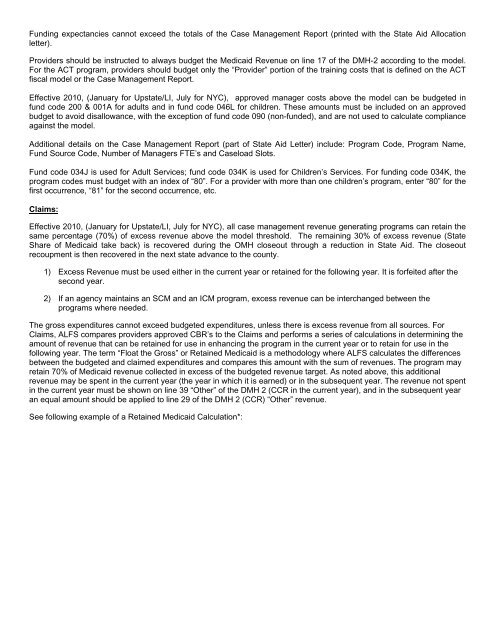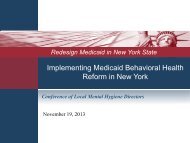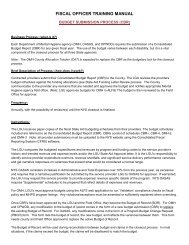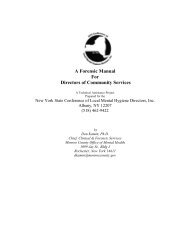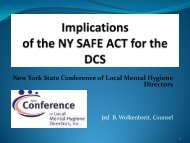fiscal officers training manual - New York State Conference of Local ...
fiscal officers training manual - New York State Conference of Local ...
fiscal officers training manual - New York State Conference of Local ...
You also want an ePaper? Increase the reach of your titles
YUMPU automatically turns print PDFs into web optimized ePapers that Google loves.
Funding expectancies cannot exceed the totals <strong>of</strong> the Case Management Report (printed with the <strong>State</strong> Aid Allocationletter).Providers should be instructed to always budget the Medicaid Revenue on line 17 <strong>of</strong> the DMH-2 according to the model.For the ACT program, providers should budget only the “Provider” portion <strong>of</strong> the <strong>training</strong> costs that is defined on the ACT<strong>fiscal</strong> model or the Case Management Report.Effective 2010, (January for Upstate/LI, July for NYC), approved manager costs above the model can be budgeted infund code 200 & 001A for adults and in fund code 046L for children. These amounts must be included on an approvedbudget to avoid disallowance, with the exception <strong>of</strong> fund code 090 (non-funded), and are not used to calculate complianceagainst the model.Additional details on the Case Management Report (part <strong>of</strong> <strong>State</strong> Aid Letter) include: Program Code, Program Name,Fund Source Code, Number <strong>of</strong> Managers FTE’s and Caseload Slots.Fund code 034J is used for Adult Services; fund code 034K is used for Children’s Services. For funding code 034K, theprogram codes must budget with an index <strong>of</strong> “80”. For a provider with more than one children’s program, enter “80” for thefirst occurrence, “81” for the second occurrence, etc.Claims:Effective 2010, (January for Upstate/LI, July for NYC), all case management revenue generating programs can retain thesame percentage (70%) <strong>of</strong> excess revenue above the model threshold. The remaining 30% <strong>of</strong> excess revenue (<strong>State</strong>Share <strong>of</strong> Medicaid take back) is recovered during the OMH closeout through a reduction in <strong>State</strong> Aid. The closeoutrecoupment is then recovered in the next state advance to the county.1) Excess Revenue must be used either in the current year or retained for the following year. It is forfeited after thesecond year.2) If an agency maintains an SCM and an ICM program, excess revenue can be interchanged between theprograms where needed.The gross expenditures cannot exceed budgeted expenditures, unless there is excess revenue from all sources. ForClaims, ALFS compares providers approved CBR’s to the Claims and performs a series <strong>of</strong> calculations in determining theamount <strong>of</strong> revenue that can be retained for use in enhancing the program in the current year or to retain for use in thefollowing year. The term “Float the Gross” or Retained Medicaid is a methodology where ALFS calculates the differencesbetween the budgeted and claimed expenditures and compares this amount with the sum <strong>of</strong> revenues. The program mayretain 70% <strong>of</strong> Medicaid revenue collected in excess <strong>of</strong> the budgeted revenue target. As noted above, this additionalrevenue may be spent in the current year (the year in which it is earned) or in the subsequent year. The revenue not spentin the current year must be shown on line 39 “Other” <strong>of</strong> the DMH 2 (CCR in the current year), and in the subsequent yearan equal amount should be applied to line 29 <strong>of</strong> the DMH 2 (CCR) “Other” revenue.See following example <strong>of</strong> a Retained Medicaid Calculation*:


